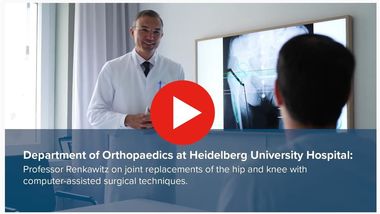Minimally invasive and computer-assisted surgical techniques in joint replacement and hip joint replacement at the Center for Orthopedics, Trauma Surgery and Spinal Cord Injury Heidelberg
Video: Interview with Prof. Dr. Tobias Renkawitz
What means artificial hip joint replacement and knee joint replacement? What advantages do "minimally invasive" surgical procedures and bone-saving implant systems offer the patient? How painful is hip replacement surgery or knee replacement surgery?
Professor Dr. habil. Tobias Renkawitz, medical director of the Clinic for Orthopedics, head of the Endoprosthetics Center of Maximum Care (EPZmax) and chair of orthopedics at the University of Heidelberg answers all these questions about artificial replacement of the hip joint and knee joint in an interview.
The Center for Orthopedics, Trauma Surgery and Paraplegiology Heidelberg develops and practices special surgical procedures
Artificial joints must be inserted very precisely in order to achieve good function and long durability after surgery. "We therefore deal very closely with the patient's individual anatomy even before the operation," explains Professor Renkawitz, who is considered an international pioneer in minimally invasive and computer-assisted surgical techniques for knee and hip joint replacement. Together with his team, he has developed surgical procedures with which artificial joints can be inserted individually for each patient with the highest precision.
During the minimally invasive procedure, the doctors use state-of-the-art surgical techniques such as computer-assisted navigation technology. This makes it possible to place the artificial joints with millimeter and degree precision.
More than 1,000 joint replacement operations are performed annually at the highly specialized Heidelberg Endoprosthetics Center. Patients are treated individually, with the highest quality and according to the latest clinical and scientific findings. In every operation, the surgical result for the individual patient is in the foreground.
Professor Renkawitz has been awarded a number of prizes for his work, including the 2014 "Medicine Oscar" from the Oskar Helene Heim Foundation in Berlin - one of the most highly endowed science prizes for physicians in Germany.
Image Gallery - Center for Orthopedics, Trauma Surgery and Paraplegiology Heidelberg
Interdisciplinary cooperation between the specialist departments at Heidelberg University Hospital promotes recovery
Treatment is carried out by a well-coordinated team in cooperation with physicians from anesthesiology, internal medicine and radiology, as well as with nurses and physiotherapy. In Heidelberg, for example, special pain therapy is practiced by combating pain where it arises during the operation: The joint specialist goes deep between two muscles in the "fast hip" by pushing the muscles to the side, but not injuring them. The precise fit of the prostheses means that replacement operations are less frequent and patients are quickly pain-free again. The minimally invasive surgical procedure also means that those treated can often get out of bed for the first time with physiotherapeutic support just a few hours after the operation.
Profile of the Heidelberg Orthopedic and Trauma Surgery Hospital
The Heidelberg Orthopedic Hospital is one of the largest and oldest hospitals for orthopaedic university medicine in Germany. Located in the Schlierbach district of Heidelberg, it combines cutting-edge medicine and orthopedics with heart on its own campus. Patients from all over the world have trusted the experienced doctors for all areas of orthopedic surgery for years.
- Endoprosthetics center of maximum care
- Shoulder/elbow and hand surgery section
- Section Spine Surgery and Spine Center
- Pediatric Orthopedics, Neuroorthopedics and Foot Surgery Section
- Technical Orthopedics
- Section of conservative orthopedics and pain therapy
- Section of orthopedic oncology and septic orthopedic surgery
- Section of sports orthopedics and sports traumatology
- Trauma surgery and reconstructive surgery
- University outpatient clinic for orthopedics and trauma surgery
- Expert opinion outpatient clinic
Second opinion service

For international patients at Heidelberg University Hospital, the specialists offer the possibility of a second opinion on knee replacement surgery or hip replacement surgery in the form of a written second opinion or a video consultation. This allows to discuss the specific case and possible next steps. After uploading findings via the telemedicine portal, specialists analyze these documents: Findings that have already been collected are reassessed and supplemented if necessary. Patients are supported with this assessment in making a sensible and good decision for further treatment.
Frequently Asked Questions (FAQ)
When does a natural joint have to be replaced by an artificial joint?
The indication remains very important. Not only the X-ray image is decisive, but also the examination and a detailed discussion in which patients are asked how long they can walk without pain, when and how often they have pain, and whether they take painkillers. The ideas and wishes of the individual patient are also very important. Only if conservative treatment options such as physiotherapy and anti-inflammatory and pain-relieving drug therapies have been exhausted does the question arise of whether to reach for the scalpel to replace the joint. In that case, artificial replacement of the knee or hip joint offers many patients the opportunity to regain mobility and achieve freedom from pain.
What experience does the Heidelberg Orthopedic Hospital have in joint replacement?
The Heidelberg Orthopedic Hospital has a long tradition in endoprosthetic care. Every year, more than 1,000 joint replacement operations are performed in the highly specialized endoprosthetics center. In every operation, the surgical outcome for the individual patient is paramount. Muscle-sparing, "minimally invasive", surgical procedures and bone-saving implant systems are standard. Since 2013, the Clinic for Orthopedics and Trauma Surgery has been one of the first university hospitals in Germany to be certified as a maximum care endoprosthetics center, and all joint replacement operations are performed by experienced and highly specialized surgeons.
How do you ensure quality?
During surgery, modern digital systems are used, for example, computer-assisted navigation when inserting an artificial knee joint. Infrared technology makes it possible to achieve a high degree of accuracy during the operation and a procedure that is individually adapted to the patient. Close on-site interdisciplinary collaboration with Internal Medicine/Cardiology, Anesthesiology/Intensive Care, Radiology and Technical Orthopedics as well as Physiotherapy/Physical Therapy ensures comprehensive care with high patient safety before, during and after surgery.
What is the procedure for knee replacement surgery or hip replacement surgery?
Artificial joints must be inserted very precisely in order to achieve good function and long durability after surgery. Therefor, the team at the orthopedic clinic examines the individual patient's anatomy very carefully before the operation and plans the operation using a wide variety of instruments. All modern imaging methods such as digital X-ray, computer tomography and magnetic resonance imaging are available. During the operation, digital surgical techniques such as computer-assisted navigation technology are used. This makes it possible to place the artificial joint with millimeter and degree precision. For example, no muscles need to be cut when accessing the hip joint; instead, an anatomical muscle gap is used.
What is meant by the "fast hip" or the "fast knee"?
Professor Renkawitz is internationally regarded as a pioneer in minimally invasive and computer-assisted surgical techniques for knee and hip joint replacement. With his team, he helped develop a special procedure that he calls "the fast hip" and "the fast knee." But that doesn't mean the goal is to operate particularly quickly - quite the opposite. In the operating room, the team takes all the time it needs to place the artificial joint safely and with high precision. "Fast hip" or "fast knee" rather means that patients can usually stand up pain-free with the help of a physiotherapist just a few hours after the operation. This is achieved, for example, by not cutting any muscles when accessing the hip joint, but by using an anatomical muscle gap. A special mobile X-ray machine is used during the operation to check whether the implant is placed precisely, and the pain is treated during the operation with a special painkiller where it occurs. The subsequent hospital stay of about 5 days is followed by a rehabilitation stay.
How painful is hip replacement surgery or knee replacement surgery?
Due to the minimally invasive and computer-assisted procedure, blood loss is extremely low and the placement of the artificial joint is very precise, so that replacement operations are less frequent and patients are quickly pain-free again. In addition, pain is treated directly with a special painkiller.
How long does it take to recover from a hip replacement and knee replacement?
"Fast hip" or "fast knee" also means that patients get back on their feet quickly after the procedure and can usually stand up pain-free with the help of a physical therapist just a few hours after their surgery. The subsequent hospital stay of around 5 days is followed by a rehabilitation stay.


